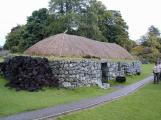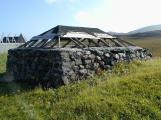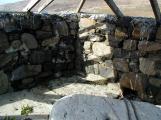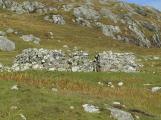3
Islands of Barra ParishIn the Old Statistical Account of Scotland, (http://stat-acc-scot.edina.ac.uk/link/1791-99/Inverness/Barray/, Barray, County of Inverness (1791-99)), Rev. Edward MacQueen states that the name of the parish appears to come from the patron saint of the Island, St. Barr. The main island is 8 miles in length and between 2 and 4 wide. Other islands, Vatersay, Sanndray, Fuaidh, Pabbay, Mingulay, Berneray, complete the make up the area of the parish.
5
LandscapeBarra, Scotland
Rev. MacQueen describes the appearance of the main island of Barra in 1794 as having a barren appearance, hilly and rocky. The inhabitants caught sea birds for their eggs, meat and feathers.
7
The Hebridean blackhouse is a long, low building with low walls, rounded ends and set back roof and thick walls to hold the heat. The stone walls of this style of home have the top of the wall exposed with the roof coming up from the inner section of the wall. This forms a shelf at the top of the wall where on a good day the people could sit and do their work while watching around them.9
Ruined Blackhouse sites are still found in Barra. The stone house which has become known as the blackhouse was built to withstand the weather conditions in Scotland.11
They were built of locally found materials such as stone (which is abundant ), thatch for the roof and what pieces of wood that could be found for the roof poles. The roof poles could be drift wood found on the shore. These poles were very valuable and if the family was building a new house they would take the poles with them to be re-used.12
Group of Blackhouse ruins29 September 2001
South Coast, Barra, Scotland
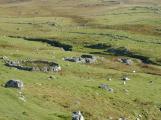 Credits:
Credits:Highland Village Museum



